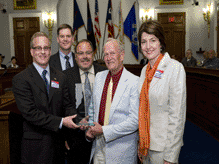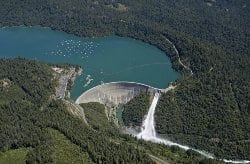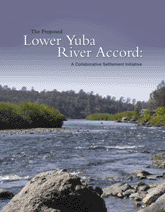Lower Yuba River Accord

The Yuba County Water Agency receives the OSAW award at NHA’s Capital Hill rally on May 11, 2009.
Summary
The Lower Yuba River Accord (Yuba Accord) concludes a 20-year California controversy and enables the Yuba County Water Agency to successfully operate the Yuba River Development Project for hydropower, irrigation, flood control, recreation and fisheries benefits — all in an innovative manner that surpasses the projects’ original requirements. As a settlement agreement, the Yuba Accord is the final product of nearly three years of intense negotiations among seventeen stakeholders, including local irrigation districts, state and federal resource agencies, and conservation groups. Based upon the success of two, one-year pilot programs, the State of California approved the agreement in 2008, and it is now fully operational. The Yuba Accord is unprecedented in that it combines increased instream fisheries flows – for wild, native salmon and steelhead – with increased supplemental water supplies for California cities and farms, while preserving all of the project’s clean, renewable hydropower generation capacity. The Yuba Accord also reaffirms the water rights of the Yuba County Water Agency and its member irrigation districts. The Yuba Accord represents a nexus of smart engineering, collaborative partnership, and strategy development in the pursuit of a sustainable solution to a complex controversy.

The Yuba River Development Project provides climate-friendly, renewable electricity to residents of Northern California. A variety of other benefits also stem from the project including recreation, irrigation, and flood control.
Background
The Yuba Accord is a culmination of Yuba County Water Agency’s (YCWA) decision to develop a collaborative solution to a conflict with fisheries groups over whether minimum flows in YCWA’s water rights permits adequately protected fish at the Yuba River Development Project (YRDP), a series of dams, reservoirs, and hydropower facilities in the Yuba River watershed.
In early 2001, more than a decade after the conflict began, the California State Water Resources Control Board (State Board) issued a decision that increased minimum instream flow requirements; directed YCWA to consult with state and federal fisheries agencies to reduce fish losses resulting from water diversions; mandated YCWA address potential concerns regarding water temperatures for Chinook salmon and steelhead; and required studies and consultation on other issues.
After legal challenges failed to significantly change the State Board’s decision, YCWA recognized the controversy was draining its resources without advancing a sustainable solution, so the Agency sought a different venue and approach to resolve this problem.

The Lower Yuba River Accord produced a sustainable solution to a 20-year legal and regulatory controversy in California. Stakeholders have praised YCWA for embarking on such a collaborative and effective water use program.
Challenge
Any alternative process faced several formidable obstacles: the number and diversity of competing interests and stakeholders on the river; multiple jurisdictional entities with specific and often overlapping areas of responsibility; the potentially high costs of resolving the competing issues; and, perhaps most difficult, the entrenched and acrimonious positions of many of the stakeholders.
The objectives necessary to secure a viable compromise agreement included several seemingly competing needs:
Implementing a level of protection for the lower Yuba River’s fisheries equivalent to or greater than the proposed State Board requirements;
Maintaining or improving Yuba County water supply management and reliability, including maintaining the ability to deliver water to meet current and future local service area needs;
Securing a revenue source to finance necessary actions and settlement costs, while providing in-lieu revenue for YCWA, and;
Retaining the operational flexibility of the Yuba River Development Project, particularly New Bullards Bar Reservoir in order to maintain generation capacity.

At the core of the Lower Yuba River Accord is an innovative set of flow schedules. The schedules were developed through negotiations between YWCA biologists, consevationists and state and federal resource agency officials.
Innovation
A biologist team from YCWA, the state and federal resource agencies, and conservation representatives spent 18 months crafting an innovative set of flow schedules that provided the most useable water possible through a range of year classes – very wet to very dry.
These instream flow schedules form the heart of three innovative agreements that comprise the Yuba Accord.
The Fisheries Agreement provides seven total year classes of flow regimes for the Lower Yuba River, a monitoring and oversight program, and a forum for ongoing multi-party decisions regarding Lower Yuba River operations.
The Conjunctive Use Agreements establish a comprehensive, voluntary conjunctive use program between YCWA and seven of its local irrigation districts.
The Water Purchase Agreement implements a long-term commitment by YCWA to provide 660,000 acre-feet of water for the CALFED Environmental Water Account and supplemental water supplies for cities and farms throughout California.
Results
As of late 2008, several key elements of the Yuba Accord were already yielding tangible results:
The Lower Yuba River Management Team (RMT) meets bi-monthly, works collaboratively to address operational and flow change decisions on the Lower Yuba, and is in the second year of an eight-year, $5.5 million study and monitoring program. This monitoring program is one of the most comprehensive single-river programs focused on endangered anadromous salmonids in California.
YCWA has made over 300,000 acre feet of additional water available both to Lower Yuba fisheries and to downstream users since the advent of the pilot programs and ultimately the Yuba Accord.
YCWA, in cooperation with PG&E, is fully utilizing the clean, renewable hydropower generation capabilities of the Yuba River Development Project.
Overall, the Yuba Accord releases up to 175,000 acre feet of water to the Lower Yuba River depending on year class and reduces the incidence of dry year flows substantially in comparison to the previous instream flow requirements that the Yuba Accord replaced.
Stakeholder Quotes
“The Accord should serve as a model for building unique alliances to find and implement integrated solutions to California’s water challenges. The most short-sighted definition of success in California’s water wars is “beating the other side.” The operative spirit of the Yuba Accord is collective problem-solving by unlikely partners; the result is a lasting outcome.” — Chuck Bonham, Director, Trout Unlimited, California
The Yuba Accord “…is a landmark achievement not only because it will improve salmon and steelhead habitat and provide certainty for water rights and irrigation, but also because it is the product of unparalleled cooperation and compromise.” — Ryan Broddrick, Director, California Department of Fish and Game
The Yuba Accord is “…an elegant solution in providing increased instream flows, water for these flows, and revenues to implement the Accord…” — Nova Blazej, Manager, Environmental Review Office, The U.S. Environmental Protection Agency, Region IX


